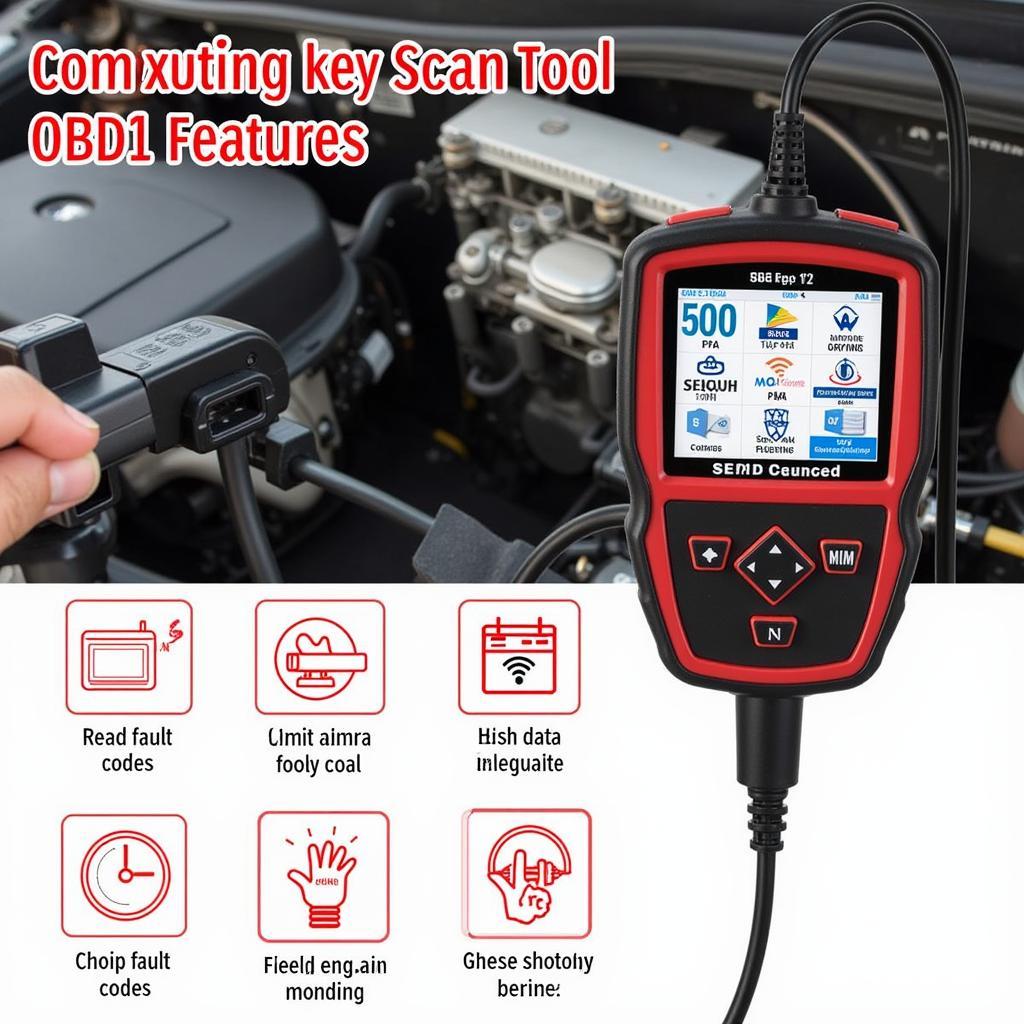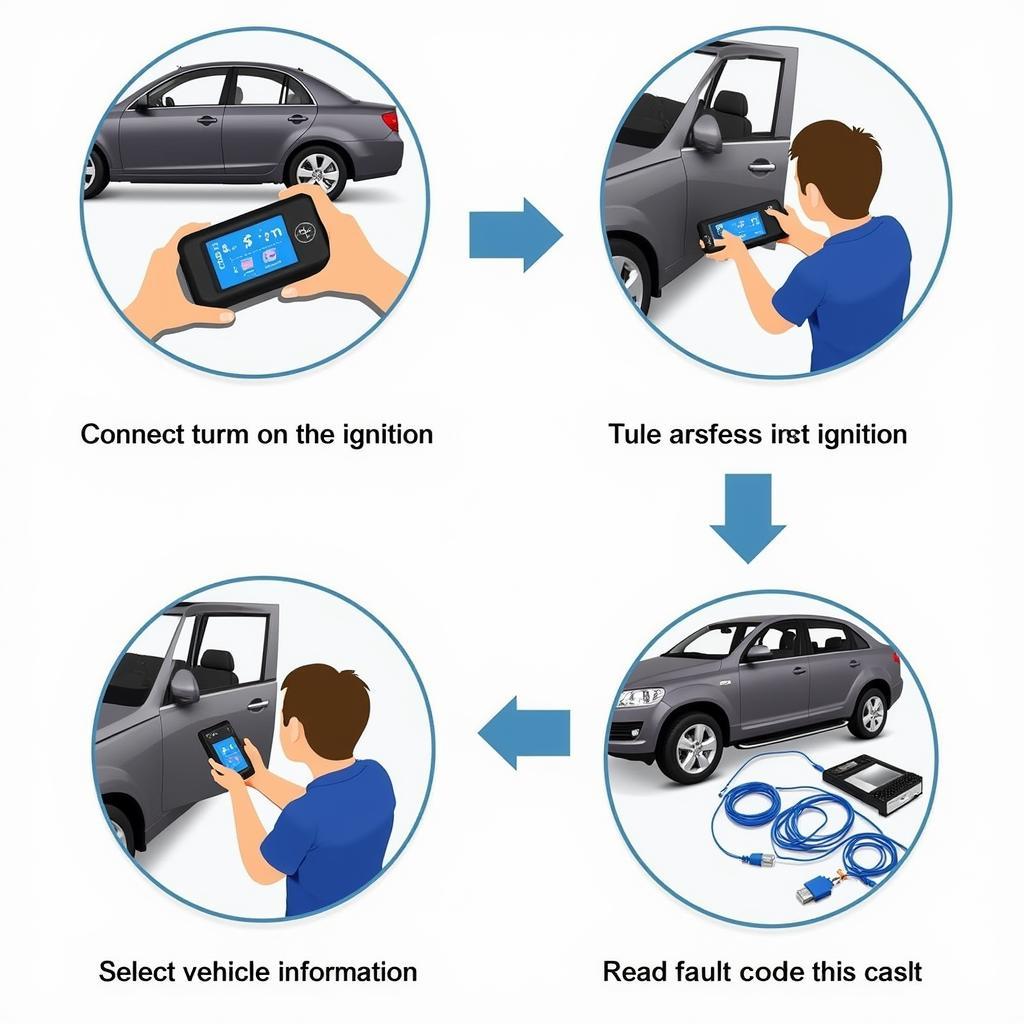The world of automotive diagnostics has advanced significantly, with OBD1 (On-Board Diagnostics) scan tools becoming essential for diagnosing and repairing issues in older General Motors vehicles. If you’re a mechanic, enthusiast, or simply want to understand your GM vehicle better, understanding the intricacies of OBD1 scan tools is crucial.
This guide will delve into the world of GM OBD1 scan tools, exploring their history, features, benefits, and how they can be used effectively to troubleshoot and resolve various problems in your classic GM car or truck.
Understanding GM OBD1 Scan Tools: A Historical Perspective
OBD1 technology was introduced by General Motors in the late 1980s and early 1990s. Unlike modern OBD2 systems, OBD1 was primarily designed to provide diagnostic information to technicians and mechanics, offering a limited set of data points compared to its successor.
These early scan tools typically connected to the vehicle’s diagnostic connector (DLC), which is often located under the dashboard, using a 16-pin connector. The scan tool would then access the vehicle’s onboard computer to retrieve fault codes and other diagnostic information.
Key Features of GM OBD1 Scan Tools
While simpler than OBD2 tools, GM OBD1 scan tools offer a range of functions that can be valuable for troubleshooting and understanding your vehicle’s health:
- Reading Fault Codes: OBD1 scan tools allow you to read and interpret diagnostic trouble codes (DTCs) stored in the vehicle’s computer. These codes provide valuable insights into potential malfunctions.
- Live Data Monitoring: Some OBD1 scan tools provide real-time data monitoring capabilities, allowing you to view sensor readings, engine parameters, and other performance metrics.
- Resetting Check Engine Light: If a fault code is resolved, the scan tool can be used to clear the check engine light, removing the warning from the instrument cluster.
 OBD1 scan tool with display showing diagnostic data
OBD1 scan tool with display showing diagnostic data
Benefits of Using a GM OBD1 Scan Tool
Using a GM OBD1 scan tool offers several advantages, making it a valuable tool for mechanics and enthusiasts alike:
- Accurate Diagnostics: By accessing the vehicle’s computer directly, OBD1 scan tools provide accurate diagnostic information, helping you pinpoint the source of problems.
- Cost-Effective Repairs: By identifying the issue quickly, you can save time and money on unnecessary repairs, making diagnostics more efficient.
- Enhanced Understanding: OBD1 scan tools can empower you with a deeper understanding of your vehicle’s performance and operation, giving you greater control over maintenance and troubleshooting.
Choosing the Right GM OBD1 Scan Tool
With a variety of OBD1 scan tools available, choosing the right one for your needs is important. Consider the following factors when making your decision:
- Vehicle Compatibility: Ensure the tool is compatible with your specific GM model year and engine type.
- Features: Determine which features are essential for your needs, such as fault code reading, live data monitoring, and check engine light reset.
- Ease of Use: Choose a tool with a user-friendly interface and clear instructions for navigating its functionalities.
- Price: Set a budget and compare pricing among different manufacturers and models.
How to Use a GM OBD1 Scan Tool: A Step-by-Step Guide
Using a GM OBD1 scan tool is a relatively straightforward process:
- Locate the DLC: Find the diagnostic connector (DLC) under the dashboard of your GM vehicle. It’s usually a 16-pin connector.
- Connect the Tool: Connect the scan tool to the DLC.
- Turn on the Ignition: Turn the ignition key to the “ON” position (without starting the engine).
- Select Vehicle Information: Select the appropriate vehicle make, model, and year on the scan tool.
- Read Fault Codes: Follow the tool’s prompts to read and interpret any stored fault codes.
- Live Data Monitoring (If Available): If your tool has live data monitoring capabilities, use it to observe sensor readings and engine performance.
- Reset Check Engine Light: If the fault code has been resolved, follow the tool’s instructions to reset the check engine light.
 Mechanic using an OBD1 scan tool to diagnose a vehicle
Mechanic using an OBD1 scan tool to diagnose a vehicle
Expert Insight:
“While OBD1 systems may seem outdated compared to their modern counterparts, they still provide valuable insights into the health and operation of older GM vehicles. Using an appropriate scan tool can be a game-changer for mechanics and enthusiasts alike,” says John Miller, a veteran automotive technician with over 20 years of experience.
Common GM OBD1 Fault Codes
Understanding common GM OBD1 fault codes can be helpful in identifying potential problems. Some frequently encountered codes include:
- Code 12: Battery Voltage Problem
- Code 21: Throttle Position Sensor (TPS) Problem
- Code 33: Knock Sensor Problem
- Code 41: Oxygen Sensor Problem
- Code 51: Vehicle Speed Sensor Problem
Troubleshooting Common GM OBD1 Issues
Using a GM OBD1 scan tool, combined with your knowledge of common fault codes, can streamline troubleshooting. Here are some examples:
- Check Engine Light: If the check engine light is on, use the scan tool to read the stored code. This code will provide information about the underlying problem.
- Engine Stalling: If the engine is stalling, use the scan tool to monitor live data, specifically the throttle position sensor and engine speed readings.
- Poor Acceleration: If the vehicle is accelerating poorly, use the scan tool to check for fault codes related to the oxygen sensor, ignition system, or fuel system.
Conclusion
GM OBD1 scan tools are essential for anyone working on or maintaining older General Motors vehicles. These tools provide accurate diagnostics, enable efficient troubleshooting, and enhance your understanding of your vehicle’s systems. By following this guide, you can effectively use a GM OBD1 scan tool to diagnose and repair a range of issues, keeping your classic GM running smoothly for years to come.
Frequently Asked Questions
Q: What is the difference between OBD1 and OBD2 scan tools?
A: OBD2 scan tools are designed for vehicles produced after 1996 and offer more comprehensive diagnostic capabilities and standardized communication protocols. OBD1 tools are primarily for older GM vehicles.
Q: Do I need a special scan tool for my specific GM model?
A: Yes, some GM models require specific scan tools depending on the year and engine type.
Q: Where can I find a GM OBD1 scan tool?
A: You can find a variety of GM OBD1 scan tools online or at automotive parts stores.
Q: Can I use a smartphone app to diagnose my GM vehicle?
A: While some smartphone apps claim to work with OBD1 systems, their accuracy and capabilities are limited. A dedicated OBD1 scan tool is generally more reliable.
Q: How do I interpret fault codes I read with my GM OBD1 scan tool?
A: Refer to a GM OBD1 fault code guide or consult with a trusted mechanic for assistance in interpreting codes.
Q: Can I reset the check engine light myself?
A: Yes, most GM OBD1 scan tools allow you to reset the check engine light after resolving the underlying issue. However, always ensure that the problem is fixed before clearing the light.
 A printed guide displaying various GM OBD1 fault codes and their corresponding descriptions
A printed guide displaying various GM OBD1 fault codes and their corresponding descriptions
If you have any further questions or need assistance with your GM vehicle, don’t hesitate to contact us at +1(641)206-8880 or [email protected]. We are here to assist you with all your automotive diagnostic needs.


